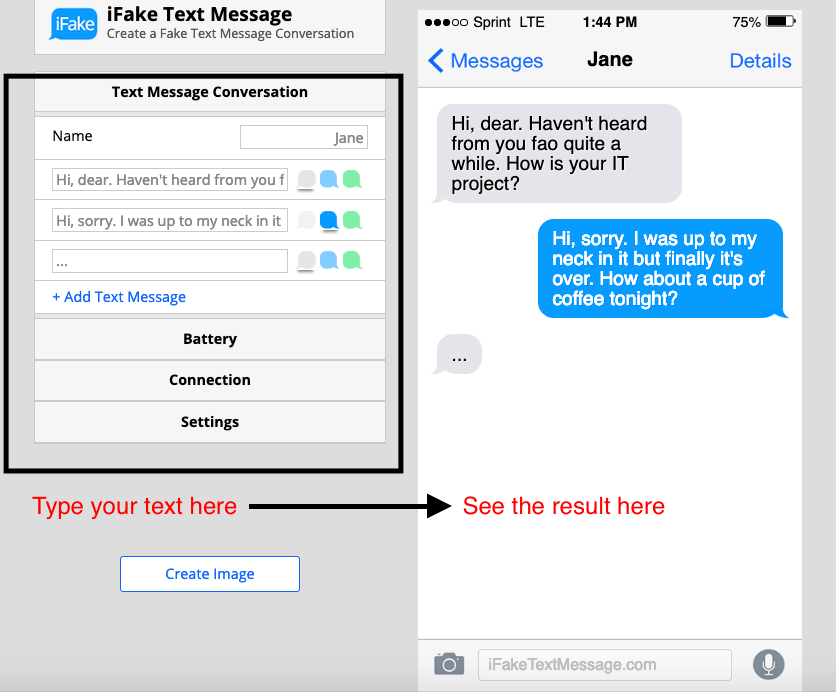Teenagers are notorious for constantly being absorbed by texting, chatting, browsing the Net and using their phones without stopping. We have come across a great opportunity to make them work in our classrooms and involve them in the learning process without their noticing. It has been recently introduced by Nick Peachey at IH Barcelona ELT Conference 2019.
Fake Messages seem to give an endless opportunity to exploit them in the ESL classroom. Let’s start with the service itself. https://ifaketextmessage.com is an easy to use tool for teachers for creating fake messages. You go on this website and start creating your conversation. Choose a name or black it out and use your imagination for a conversation. You can add some visuals like the battery level, level of the signal and other features to make your message feed even more realistic.

This is a powerful tool to use with your teens as it enables you to work on any skill and any topic, be it grammar or vocabulary! So, let us be more specific and give you some examples of possible tasks you can create.
You can use it as:
1. A lead-in: use a conversation to create an idea of what your lesson is going to be about. For example, if your lesson is going to be about clothes, you can start it with:

2. A pre-listening/pre-reading activity: use the names which are used in the dialogue/text you are going to work on later in the lesson and ask them to predict the content, write some question they want to find out about what is going to happen. In this particular task, ask your students to give ideas on why this person doesn’t want to be friends with the other anymore. Ask them to read the text later and check their ideas.


3. Reading for gist: it can be set for low-level students. After reading you can ask them to choose the main idea, pick a picture which best describes what is going on in the text, or predict what the dialogue is going to be about.
4. Reading for specific information: make a dialogue, cut it out and ask your students to put it in the logical order.
5. An after reading/listening activity: again, make a conversation of two people starting to discuss what the listening/reading task was about and let your students go on with sharing their opinions on what they have heard and how they feel about it.
6. Grammar practice: let your students put the dialogue in the Reported Speech or complete the gaps during the controlled practice stage. You can leave out auxiliary verbs in questions or ask your students to change the tense from, say, Present Simple to Past Simple. Here, opportunities are absolutely endless as you can go on with Third Conditionals and express regrets or imagine what they would do if they were in such a situation.
7. An error correction or fossilised errors task: make a conversation and add there the most common mistakes your students make. Ask them to work in pairs and find and correct them. Make mistakes in word order in questions and indirect questions. Forget about ‘-s’ in 3rd person singular Present Simple or the forms of the verb “to be” in Continuous tenses. You can make some spelling mistakes if your students cannot remember how to write some words.
8. Functional language practice: practice the language of suggestions and giving advice, agreeing and disagreeing. Make a suggestion, arrange your students in pairs or small groups and practice the dialogues.
9. A speaking task: just give your students the intriguing first lines of a conversation and ask them to make up the ending. Let them work in pairs. Another way is to add only questions and let your students kind of interview each other completing the dialogues with their own ideas.
10. Setting a writing task: make them write a longer piece of writing such as an informal email, letter of complaint or even an essay on a controversial topic discussed in a conversation. On the other hand, nowadays students are not into writing at all, but they are close to technology, so you can ask them to write a text message to their friends instead.
11. Decoding abbreviations and acronyms widely used in short messages among native speakers. Hide some words behind some of these acronyms and ask your students to decipher and create their own. This will engage students and get you closer to working on 21st-century skills. A list of commonly used acronyms can be found here.






 Вероника Аветисян
Вероника Аветисян 
 Маргарита Аветисян
Маргарита Аветисян 


